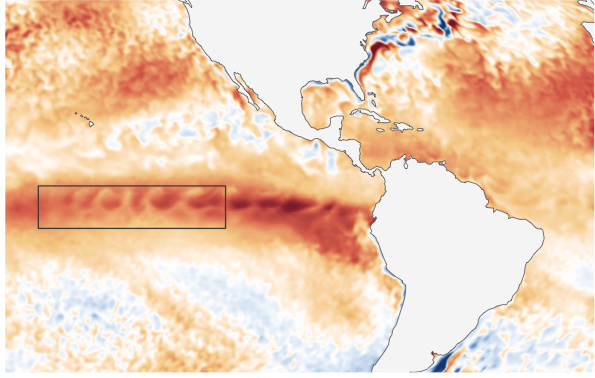The intensification of El Niño is contributing to a rise in global temperatures
Anomalies in ocean surface temperatures


El Niño Strengthens in the Pacific, Raising Concerns About Extreme Heat and Climate Change.
El Niño, a natural climate phenomenon known for its far-reaching impact on weather patterns, is gaining strength in the tropical Pacific Ocean. This development is expected to have a significant influence on global average temperatures in the coming year. The implications of this El Niño event are far-reaching, affecting regions with droughts and floods and raising concerns about the broader context of climate change and its consequences.
The National Oceanic and Atmospheric Administration (NOAA) recently provided an update, categorizing the current El Niño as “strong.” According to their projections, there is a greater than 55% chance that this El Niño will maintain its strength from January through March. Compared to the previous month, NOAA has slightly increased the likelihood that this event will become historically strong during the November-to-January period, estimating a 35% chance of this occurrence. Furthermore, NOAA anticipates the El Niño event to persist into the Northern Hemisphere spring.
It’s worth noting that El Niño and its counterpart, La Niña, are natural climate phenomena driven by sea-surface temperatures in the tropical Pacific Ocean. El Niño is associated with the warming of these waters, while La Niña is linked to cooling. These events significantly influence weather patterns around the world, impacting everything from temperature records to floods, heat waves, and even the intensity of tropical cyclones.
The last strong El Niño event in 2015-2016 led to a record-warm year. Now, it appears that the current El Niño could push global temperatures even higher, potentially surpassing previous records. This underscores the concern expressed by climate experts like Andrew Pershing, VP for Science at Climate Central, who remarked, “El Niño is really going to start to bite next year.”
Despite the potential for significant temperature increases, it’s essential to recognize that El Niño’s direct contribution to the record warmth observed during the 12-month period from November 2022 through October 2023 is relatively small, estimated at about 0.04°C (0.07°F). However, experts believe that this influence is likely to grow through 2024. This highlights the complex interplay of natural climate cycles like El Niño with the broader context of human-caused warming, primarily driven by the burning of fossil fuels.
Climate change is a pressing issue, and extreme weather events like those associated with El Niño are becoming more frequent and intense. These events have serious implications for food security, water resources, and overall environmental stability. Organizations like the World Meteorological Organization (WMO) and the Copernicus Climate Change Service are actively monitoring and researching these patterns to improve early warning systems and deepen our understanding of their consequences.
In conclusion, the strengthening El Niño in the Pacific Ocean raises concerns about the potential for extreme heat and its interconnectedness with climate change. While El Niño is a natural climate cycle, its effects on weather patterns have far-reaching consequences. It is crucial that we continue to study and address these phenomena as part of the broader effort to mitigate climate change and safeguard our planet’s future.
By: M Z Hossain, Editor Sky Buzz Feed















